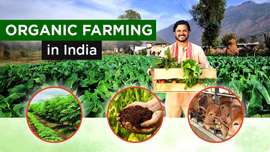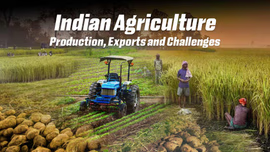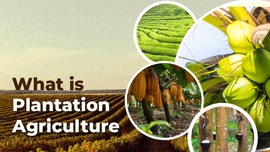Mixed Farming in India – Types, Characteristics and Advantages

Mixed farming is one of the old farming practices in India which involves a balanced relationship between crop production and animal husbandry to offer a variety of benefits to farmers. Today’s blog explores the concept of mixed farming in India along with its types, advantages, characteristics and some unique success stories.
Table of Contents
- Mixed Farming- A Sustainable Farming Approach
- What are the Different Types of the Mixed Farming System?
- What are the Characteristics of Mixed Farming?
- What are the Advantages of Mixed Farming?
- Success Stories of Mixed Farming in India
Mixed Farming- A Sustainable Farming Approach
Growing of crops and raising livestock simultaneously on a single piece of land is called mixed farming. It is a multi-purpose practice where a crop can be grown along with farming activities like livestock rearing, beekeeping, fisheries, poultry, etc. The objective is to create as many sources of subsistence as possible. Initially, it served domestic consumption but now, it is also being preferred for commercial production.
In India, crop cultivation is the major source of income for farmers. Thus, if the demand and supply of that crop are misjudged and the market situation becomes imperfect, then the farmer's income will be affected adversely. Therefore, improving the farmer's potential for sustainable agriculture with higher returns is important for food security in developing countries. This can be done using the mixed farming method because it offers better returns to farmers and higher productivity.
What are the Different Types of the Mixed Farming System?
There are different types of mixed farming practiced in India. Some of the most common types of this farming are discussed below.
Integrated Crop Livestock Farming
In this type of farming, farmers grow crops and livestock on the same farm. This is the most common practice of mixed farming which increases crop yields, soil biological activity and nutrient recycling, reduces soil erosion and intensifies land use. Both crops and livestock are dependent on each other, and their waste products serve as a resource for the other. For instance, manure is used to enhance crop production; crop residues and by-products feed the animals, thus contributing to improved animal nutrition and productivity.
Agroforestry
Agroforesty is the integration of trees with crops or animals through rotational practices, or both, which serves as a sustainable mixed farming practice. It effectively reduces soil erosion, deterioration of farms, surface and groundwater pollution and thus increase biodiversity. In this system, an understory crop acts as the primary crop while the canopy trees provide a secondary crop of fruit, fodder, fuel or timber products.
Integrated Aquaculture Farming
The integrated aquaculture farming is the mutual benefit for the fish and plant. It involves farming soilless plants and raising fish in tanks. This creates a balanced system where the water used for the plants gets purified for the fish, and the water from the rearing of the fish acts as a natural fertiliser for the plants due to its nutrient-rich characteristics.
What are the Characteristics of Mixed Farming?
Mixed agriculture involves crop production and animal husbandry for complimentary usage of crops and livestock. Its main characteristics have been mentioned below:
- Crop production and animal rearing are practiced on the same piece of land. Mixed farming is usually done on an average-sized farm.
- It uses crop by-products in the best manner and converts them into valuable animal products like farmyard manure.
- Organic manure is mostly used in the mixed farming system. It is widely available due to the presence of an animal husbandry facility nearby.
- Farmers have diversified income sources as they deal with different agricultural outputs, including crops, dairy products, and meat.
- Crop remains are used for fodder. After crop harvesting, farmers use the crop remains to feed the animals, thereby saving money on buying animal food and getting quality products like milk or meat.
- Like commercial farming, it also involves the use of different types of farming tools, small agricultural implements and heavy machinery like tractors.
- This farming method is a mix of commercial production and subsistence farming. Commercial mixed farming grows high value cash crops that are intended for human consumption and sale in markets.
What are the Advantages of Mixed Farming?
Higher Productivity: Due to efficient land use, mixed farming offers higher productivity. Animals raised on the farm provide manure that can be utilized as fertilizers to improve soil fertility. Fertile soil means higher yields and more money for farmers.
Efficient Resource Use: A mixed farming system allows efficient use of resources. For instance, crop cultivation and animal rearing use the same crop. Crop residues become fodder for animals, and their manure turns into fertilizers for soil. Thus, production costs are minimized, and profitability is increased.
Risk Management: Risk management is the key advantage of mixed farming. It allows farmers to mitigate risks and losses related to crop damage because of pests, diseases, and crop failures. Losses are minimized even if there is low yield or crop failure, as they can still use animals and their products as income sources.
Intensive Farming: Mixed agriculture involves higher chances of intensive farming. Intensive cropping is adopted to fulfil the demands of feed and fodder for the cattle. Also, it helps to meet the requirements of different crops, including vegetables and grains.
Higher Profits: Its output offers a wide range of products that are sold at high profits in the market. For example, milk and dairy products are consumed on a large scale in India.
Success Stories of Mixed Farming in India
Integrated Farming in Hasanapur Village, Karnataka
Mr. Muttappa Pujari (45), owns 8 acres of land, two oxen and two goats. He grows red gram, cotton, ginger, wheat, chilli, chickpea, etc. on his farm. Along with farming, he also actively engaged in fish farming. By doing mixed farming for years now, Mr. Pujari gets Rs. 4 to 5 lakh net profit from his 8 acres of land. He purchased two goats worth Rs. 3,500, and within two months, he sold them for Rs. 7,000, with a profit margin of Rs. 2,500 after deducting the expenditure. In future, Mr. Pujari plans to start commercial goat, poultry and fish farming in partnership to increase his net income.
Integrated Farming in Uchana Village, Karnal District, Haryana
Mr. Narinder Singh is a 54-year-old farmer who is engaged in horticulture crops such as apple, jamun, pear, peach, mango, litchi, etc. was the first person to introduce apple in Haryana, which was named as “Rana Gold Apple” and he started selling apple seedlings in the district. He is also known as the “Apple Man of Haryana”.
Along with the nursery, he took up bee-keeping, crop production, vermi-compost and so on. He takes care of 15 cows that yield 180 litres of milk per day. He also maintains 350 beehive boxes that provide 27-30 kg of honey. While having passion for agriculture, he proved himself when his advice of keeping bee boxes in orchards led to a 15-20 percent increase in the yield. These boxes were supplied by him for the part of the Narmada Project. He was also awarded with Best Bee-keeper in Haryana State, by ICAR-NDRI (National Dairy Research Institute), Karnal, Haryana.
Mixed Farming in Thimmalapura Village, Karnataka
On 0.8 ha piece of land, Mr. Manjanna T.K. grows ragi and red gram, horticultural crops such as banana, mango and coconut, and he also maintains a nursery and does beekeeping, along with owning one milch cow. Earlier, he used to grow crops like coconut as a sole crop but with time, he started using his land in between trees by growing Jasmine and Chrysanthemum as an inter crop, which gave him additional income. Later, he started growing red gram and chilli in between rows of mango. With the proper use of this integrated method, he also started growing banana as an inter-crop in a coconut orchard.
Frequently Asked Questions On Mixed Farming in India – Types, Characteristics and Advantages
1. What is mixed farming?
Mixed farming is a system that not only grows crops but also raises livestock.
2. Where are mixed crop and livestock farming practiced?
Mixed farming is practiced in many states in India, including Kerala, Punjab, Uttar Pradesh and Gujarat.
3. How does mixed farming help in conservation of soil?
Mixed farming involves practices like crop rotation that enhance soil fertility and prevent soil erosion.
4. Which crops are grown in mixed farming?
Mixed farming grows a variety of crops, including maize, legumes, black pepper, and cocoa.


Related Blogs












